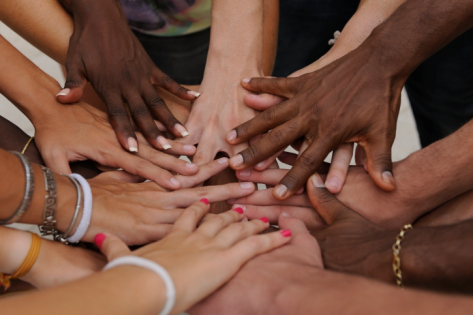Time Required
Take 15 minutes to go through the steps below. Try to repeat these steps with a different person at least once per week.
How to Do It
- Choose a person in your life who seems to be very different from you in every way that you can imagine. They might have different interests, different religious or political beliefs, or different life experiences. They might even be someone with whom you have had a personal conflict, or someone who belongs to a group that has been in conflict with one of your social groups. You don’t have to pick someone who makes you feel nervous or unsafe.
- Make a list of the things that you most likely share in common with this person. Perhaps you both work for the same company or go to the same school. Maybe you both have children, or a significant other. Probably you have both had your heart broken at one point or another, or have lost a loved one. Remind yourself that you and this person are both human beings.
- Review the list you made. Do the things you listed make you see this person in a new light? Instead of simply seeing this person as unfamiliar or as an outsider, try to see them as a regular person, one whose tastes and experiences might overlap with yours in certain ways.
- Repeat this exercise. Try it whenever you meet someone who initially seems different from you, who has a conflict with you, or who you feel uncomfortable around.
Why You Should Try It
Research suggests that humans have a deeply rooted propensity to be kind and generous, but some obstacles can prevent us from acting on those altruistic impulses. One of the greatest barriers to altruism is that of group difference: We feel much less motivated to help someone if they don’t seem to belong to our group or tribe—that is, if they’re not a member of our “in-group”—and we may even feel hostile toward members of an “out-group.”
But studies have consistently found that who we see as part of our “in-group” can be malleable. That’s why a key to promoting altruism, which involves acting to promote someone else’s welfare even at a risk or cost to oneself, is recognizing commonalities with someone else, even if those similarities aren’t immediately apparent. This exercise is designed to help expand one's sense of shared identity with others.
Why It Works
Although people generally want and try to be altruistic, they may also feel competitive toward people outside of their “in-group,” and the boundaries of their in-group might shrink at times when resources seem scarce or they are fearful for their safety. Reminding people to see the basic humanity that they share with those who might seem different from them can help overcome fear and distrust and promote cooperation. Even small similarities, like recognizing a shared love of sports, can foster a greater sense of kinship across group boundaries. Importantly, recognizing commonalities doesn’t mean negating differences, but may in fact help people value differences rather than feeling threatened by them.
Evidence That It Works
Levine, M., Prosser, A., Evans, D., & Reicher, S. (2005). Identity and emergency intervention: How social group membership and inclusiveness of group boundaries shape helping behavior. Personality and Social Psychology Bulletin, 31(4), 443-453.
Participants were more likely to help a fallen jogger when the jogger was a fellow fan of the same soccer team than when the jogger was a fan of a rival team (as indicated by their shirt). But when participants were reminded of a shared identity with the fallen rival (being a soccer fan), they were more likely to help than they were to help a non-fan.
Leary, M. R., Tipsord, J. M., & Tate, E. B. (2008). Allo-inclusive identity: Incorporating the social and natural worlds into one's sense of self. In H. A. Wayment & J. J. Bauer (Eds.), Transcending self-interest: Psychological explorations of the quiet ego (pp. 137-147). Washington: APA.
Participants who reported feeling a greater sense of connection to other people, regardless of group distinctions, and to the natural world at large also reported less egocentricity, more concern for others, and less interest in having power over others.
The Shared Identity practice can expand our “in-group” and help us feel a sense of kinship with others. How concerned are you about your community, your fellow citizens, and all of mankind? Take the Connection to Humanity quiz to find out.

 This practice is part of the
This practice is part of the










Comments
and Reviews
Johanna Witt
It’s a good practice but I don’t really like it. It’s difficult and sometimes it helps but there are also people were it just makes you wonder how they ended up as unappreciative as they are. I think there’s a lot of potential for it to backfire.
Gavin
Cheryl Ashland
Good activity for building compassion.
Jane G
I was not successful with this practice. I chose somebody I really can't relate to on any level except maybe 'we both breathe air.' I won't go into why. I think it is definitely a worthwhile practice and I shall keep it in mind and try it on other 'subjects.'
Elena Broslovsky
this practice is not new to me. I lived in a community that built circles of empathy into our daily life. A safe spot for people to air differences and find common ground and agree to hug or high five after no matter what was said
Rosie Horsley
It’s a very good practice. It immediately becomes apparent that I can overcome resistance to people I’m not ‘in tune with’ by applying the tools of seeing them as similar to me somewhere. We are all human, and beneath the personality traits each one of us is hiding fears and doubt’s about ourselves and our place in the world. None of us know what another person has been through in their lives. I really got a lot out of this practice.
The Greater Good Toolkit
Made in collaboration with Holstee, this tookit includes 30 science-based practices for a meaningful life.
The Greater Good Toolkit
Made in collaboration with Holstee, this tookit includes 30 science-based practices for a meaningful life.